This is an Arctic tern (Sterna paradisaea) which can often be seen hovering six metres above the water before diving vertically for small fish.
When you start sea kayaking, you're probably too busy to pay much attention to the creatures that live there. Later on it's the creatures that bring you back when it's windy, the sun isn't shining and there's a spatter of rain. It's a privilege to kayak in an area with a healthy marine environment.
Adult seals
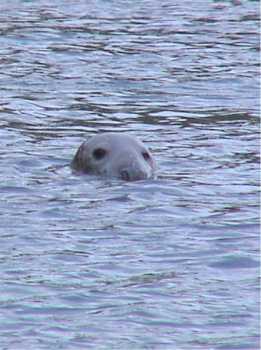 Usual pupping times in north-west Europe:
Usual pupping times in north-west Europe:
October-December (grey seals, Halichoerus grypus, the ones with a Roman nose).
June-July (the harbour seal or common seal, Phoca vitulina, the ones with a dog-like head).
The total world population of grey seals is about 300,000. Most of them live in the north Atlantic, equally divided between the western and eastern sides. Most of the eastern population lives in Scotland. Various sub-species of the common seal are widely distributed round the coasts of the Atlantic and Pacific. The world population is estimated at 400,000-500,000 and stable.
The number of common seals around Britain has declined catastrophically in the last few years. In the isles of Orkney it halved between 2003 and 2009 and is still declining. The reason is not clear but is believed to have something to do with over-fishing, particularly of sandeels, and climate change. Although the reason for low fish stocks in the Atlantic is many years of over-fishing, fishermen often feel that seals are to blame and have called for permission to cull them or kill them for sale. Presently, they are protected by law unless they damage fishing nets but there is some illegal shooting.
In the Netherlands, seal protection, rehabilitation and research are well organised by the SRRC (the Lenie 't Hart Seal Rehabilitation & Research Centre) which has a network of eighty seal first-aiders round the coast. On their English-language website they say "it is clear that humans are usually the cause of seals’ distress. They dump chemicals, throw entangled sea-fishing tackle overboard, or frighten nursing mothers. The story repeats itself over and over: Human activities endanger these animals. We, at the SRRC, think it goes without saying that we should take responsibility for the animals that wash ashore, help them and set them free again afterwards in their natural habitat." The Marine Mammal Center, Sausalito, has eight hundred volunteers throughout California and also undertakes community education and conservation. They find that 10% of casualties have been injured by net and fishing line entanglements, gun shots, handling by humans, and boat
strikes.
Seals tend to ignore motorised fishing boats, especially if they pass by regularly, but they are curious about kayaks and often follow them. A few like to go right up to kayaks or even climb on board. Most do not, and evidently feel threatened by a kayak going directly towards them, or even by direct eye contact with kayakers. They are very good at coming up behind you.
If a diver or kayaker is quiet for long enough, a young seal may come right up to them, but most seals view a sea kayaker as a predator of unknown speed and ability. And that's not far from the truth. When there is a kayak about, a seal feels happy in water but not on land. If a seal on land sits up to get a better look at you, it's time to back off. We respectfully suggest that the right approach is not how close can I get to that seal before it crashes into the water and swims off but "how close can I get before it gets stressed and starts arching itself up like a banana to keep a better eye on me."
If you see a beach covered in seals, it must be a breeding beach or nursery. There are few of these and their location is not made public. The best thing is to stop without splashing; keep silent; turn round and go back, so that you are at least 150 metres away from the beach.
Baby seals
Newborn seal pups are skinny and weigh only about 15 kg. On diet of milk that is 60% fat they fill out and put on more than 35 kg in weight in three weeks. Grey seal pups are born with a white pelt (lanugo) and are unable to swim until they get their adult pelt at four weeks. Common seal pups are usually born able to swim but some are in lanugo for their first week.
The general rule
LEAVE THEM ALONE! That is almost always the right answer.
Baby seals are often left on their own when their mothers are off fishing. The mother probably knows you are there and will not approach until she thinks you have gone away. The baby does not need to be rescued and if you handle it, changing its scent, the mother may abandon it.
Taking a lone baby to a rescue centre does not guarantee it will survive the next few days, nor that it will be able to adjust to life in the wild on release. Official advice from the RSPCA is "watch from a distance for at least 24 hours to see if mum is still around before requesting help. If the seal is on a beach with lots of people and dogs then you may need to act sooner."
If you find a baby seal that seems distressed, don't touch, report it by telephone. There are many privately-run seal sanctuaries and rescue centres round the coast. To find one in the UK you can telephone the RSPCA on 0300 1234 999, or British Divers Marine Life Rescue on 01825 765546. BDMLR has a very good website at www.bdmlr.org.uk and they also run marine mammal medic courses. Not free but sounds good. See Courses & Holidays.
We have mentioned seal rehab organisations in the Netherlands and California. Elsewhere in north America you can find a rehabilitation centre by calling your local Game & Fish Department, Animal Control Officer, Humane Society, or veterinarian.
Exceptions to the rule
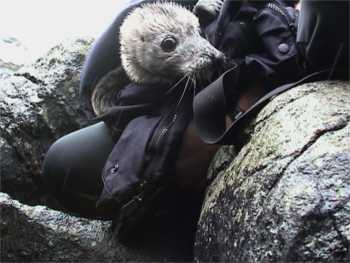 There are a few cases where the baby gets lost during bad weather or the mother has no milk, making a rescue centre the best option.
There are a few cases where the baby gets lost during bad weather or the mother has no milk, making a rescue centre the best option.
This baby was a few days old and still all skin and bones. He was very dehydrated, with saliva so thick he seemed to be foaming at the mouth and he lacked the usual black patches of moisture on the facial fur below the tear ducts. Being very skinny, he was shivering and borderline hypothermic. Seals have a very powerful bite but this one was too young to cause any damage. He was observed over a long period from a long distance away but his mother did not show up. He was then taken from the beach to a specialist centre which fed him. From the time it took for him to start producing faeces it was apparent that he had never fed since birth, so THIS TIME rehab had been the correct response. He was kept from too much human contact and released near the local seal colony a few weeks later. It is not known whether they accepted him.
Whales & dolphins
For images of the whales, dolphins and porpoises that can be seen in some Scottish waters, see the website of the Hebridean Whale & Dolphin Trust. They kindly agreed to let us reproduce some here. HWDT does valuable work in education and research.For example, by photo identification of individual animals they have determined that there are fewer than 60 bottlenosed dolphins in the Hebrides, which is relevant to the measures needed to protect them. Please visit and make a donation, large or small.
Minke whales up to 10 metres long are quite often found in some places off the coast of Scotland, sometimes with young calves. They can easily be recognised by their size and by their unexpectedly small dorsal fin, which is set well back towards the tail. They are not endangered but kayakers should avoid going directly towards them, surrounding them on the surface or approaching closer than 100 metres, or 200 metres if there is a calf present.
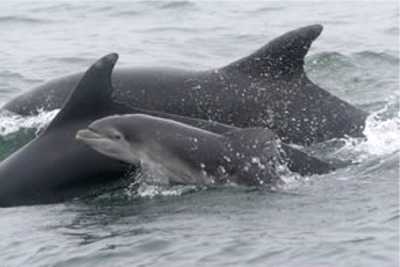 There are many species of dolphin, some of which are in danger of extinction. Many local populations are at risk of disappearing. The bottlenose dolphin is not at risk globally, but in Scotland it is estimated that there are now less than 100 on the entire west coast and less than 130 in the Moray Firth, where powerboats take tourists out for a look. The Moray Firth population is estimated to be declining by 6% per year due to accumulation of chemical pollution in their tissues, getting caught in fishing nets, harassment, collisions with boats, water pollution and over-fishing of their food stocks.
There are many species of dolphin, some of which are in danger of extinction. Many local populations are at risk of disappearing. The bottlenose dolphin is not at risk globally, but in Scotland it is estimated that there are now less than 100 on the entire west coast and less than 130 in the Moray Firth, where powerboats take tourists out for a look. The Moray Firth population is estimated to be declining by 6% per year due to accumulation of chemical pollution in their tissues, getting caught in fishing nets, harassment, collisions with boats, water pollution and over-fishing of their food stocks.
Dolphins seem to be more intrigued than anything else by kayakers, but we should avoid approaching closer than 50 metres. If they approach you, that's another matter. It has been known for a pod of dolphins to accompany kayakers, outpace them and then come back a few minutes later to put on a show of synchonised leaping. Picture of dolphins and baby courtesy of HWDT.
Porpoises are not endangered but they are shy. Again, kayakers should avoid going directly towards them or boxing them in.
Orca or killer whales can also reach 10 metres in length, six tonnes and 60 kilometres per hour. The total global population may be as low as 50,000 but estimates are unreliable. Some local populations are endangered or have recently disappeared but the overall population trend is unknown. They require little protection from kayakers as they are quite capable of eating anybody who teases them. They are seldom seen in Scottish waters, where they generally eat fish and occasionally take seals and harbour porpoise. If they ever snack on a kayaker, they must be choosing times when there are no witnesses... Being the top of the maritime food chain, orca have suffered from organochlorine pesticides formerly used in farming and fish-farming. For example DDT, dieldrin, GammaHCH/ lindane and pentachlorophenol. Most of these fall within the Stockholm Convention on Persistent Organic Pollutants and are therefore banned in most western countries
Not long ago one Kayarchy contributor spent twenty minutes amongst three orca between the islands of Mull and Coll. When he first saw their spouts he thought it was spray from waves breaking on the north-west cliffs of Mull, then he though no, probably dolphins. He manoeuvred to let wind and waves carry him down on the "dolphins" so he would drift through the pod inconspicuously, but when it was too late to back off he saw the black/white colouration and huge dorsal fin of the male, and realised they were orca. Three big ones, cruising along just under the surface as they fed on herring. A Force 5 westerly wind was creating two-metre waves and ruffling the surface of the sea, but oil spilt from the herrings had created a glassy-smooth patch the size of a football field, into which sea birds were diving for their share. The largest orca, which had a floppy dorsal fin, headed straight towards him on the surface and dived while about 20 metres away. Gulp. But it came up elsewhere. Then he went back round upwind and drifted through the pod again. That time two of the orca stopped on the surface, 15 metres away and pointing towards him, while they had a good look to confirm what they already knew from sonar. Terrifying but wonderful, he says. He didn't try his luck a third time.
Otters
 Possibly this planet's most attractive animal. See the film Ring of Bright Water (Bill Travers, Virginia McKenna, 1969). This picture was taken by Murty Campbell from his sea kayak.
Possibly this planet's most attractive animal. See the film Ring of Bright Water (Bill Travers, Virginia McKenna, 1969). This picture was taken by Murty Campbell from his sea kayak.
Breeding times in north-west Europe: All year round. NEVER disturb or follow a female with cubs or a cub on its own. Don't approach or try to carry out surveillance of a location where you think there may be cubs.
Avoid camping near otter paths. These are about 15 cm wide, lead from the water to a shelter, typically amongst boulders or tree roots, and are marked with otter droppings (spraints) which are typically black, oily-looking and smell of fish.
The European otter, Lutra lutra, is sometimes called the common otter but its status on the IUCN Red List is "decreasing, near threatened". They have abandoned large areas including the Netherlands, Switzerland and most of England because of hunting (now illegal), intensive farming and management of river banks. They have also suffered from organochlorine pesticides.
European otters are hard to see in the wild, being well camouflaged, very shy of humans and very alert. This one has not yet noticed the kayak because he is hunting small crabs in the seaweed. They prefer fresh water but can be seen playing or hunting on the coast, especially where a river or stream enters the sea. They move around a lot, over long distances. If you see one several times in the same location, it may well be a female with a family nearby.
Sea birds
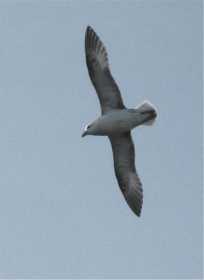 Nesting times in north-west Europe: Eggs hatch in May-July for those which nest on cliffs and on the ground, chicks fledge in August for those which nest in burrows such as puffins, shearwaters and petrels.
Nesting times in north-west Europe: Eggs hatch in May-July for those which nest on cliffs and on the ground, chicks fledge in August for those which nest in burrows such as puffins, shearwaters and petrels.
Other vulnerable times: Midwinter
If your kayak gets too close to any cliff of nesting birds such as razorbills and guillemots, the whole colony is liable to explode into flight, with eggs getting chilled and chicks falling into the sea.
Fulmars (illustrated) are the elegant, quiet ones which seldom flap their wings in flight. When they see a kayaker at sea they often come out and make a few close passes, apparently out of curiosity, but they become distressed if a human goes near the foot of their nesting cliff.
Puffins are delightful and may let a human get almost close enough to touch, both on the water and at their cliff-top burrows, but doing so puts them at risk. Puffins form rafts at sea. They are resting after fishing, and in breeding season they will shortly fly back to the nest to feed their chicks. If you get too close they may dump the food before flying, leading to starvation for the chicks.
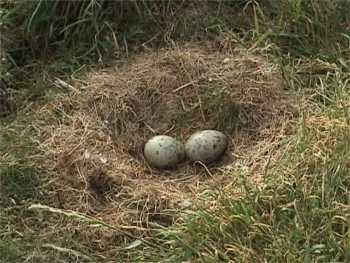 Some species such as arctic terns nest only on the shingle or grass of small islands, so kayakers need to take care at lunchtime stops.
Some species such as arctic terns nest only on the shingle or grass of small islands, so kayakers need to take care at lunchtime stops.
If you're in an estuary when you see a pair of shelduck ahead of you on the water with fifteen little balls of fluff, it's a good moment to make an immediate sharp change of course so that you miss the happy family by 50 metres.
The sandpiper, turnstone and many other birds survive cold weather by staying inactive to conserve energy, and may die if much disturbed.
Estuary birds
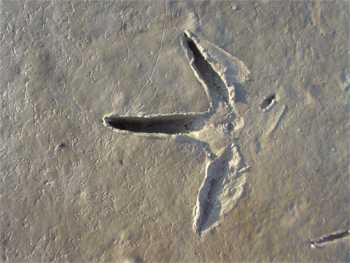 Sensitive time in north-west Europe: October-March
Sensitive time in north-west Europe: October-March
Estuary mud flats are vital winter feeding sites for many northern birds, which are at risk if put in fear, whether by wildfowlers or sea kayakers. A bird which has just flown in from the Arctic, or from Siberia in the case of the barnacle goose, is at the end of its resources and may die if not allowed to feed undisturbed.
The best place to observe them is from a bird-watcher's hide, not a kayak. If you have to go past them, try to avoid approaching in such a way that they take flight.
Go to next page for:
• Contents of Activities chapter
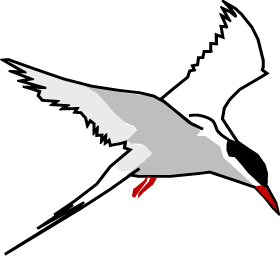
 Usual pupping times in north-west Europe:
Usual pupping times in north-west Europe:  There are a few cases where the baby gets lost during bad weather or the mother has no milk, making a rescue centre the best option.
There are a few cases where the baby gets lost during bad weather or the mother has no milk, making a rescue centre the best option. 
 Possibly this planet's most attractive animal. See the film Ring of Bright Water (Bill Travers, Virginia McKenna, 1969). This picture was taken by
Possibly this planet's most attractive animal. See the film Ring of Bright Water (Bill Travers, Virginia McKenna, 1969). This picture was taken by  Nesting times in north-west Europe: Eggs hatch in May-July for those which nest on cliffs and on the ground, chicks fledge in August for those which nest in burrows such as puffins, shearwaters and petrels.
Nesting times in north-west Europe: Eggs hatch in May-July for those which nest on cliffs and on the ground, chicks fledge in August for those which nest in burrows such as puffins, shearwaters and petrels.  Some species such as
Some species such as  Sensitive time in north-west Europe: October-March
Sensitive time in north-west Europe: October-March